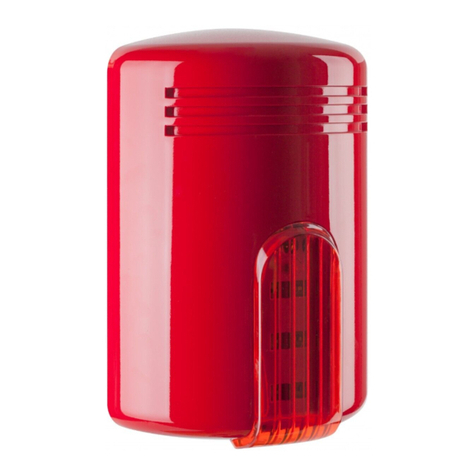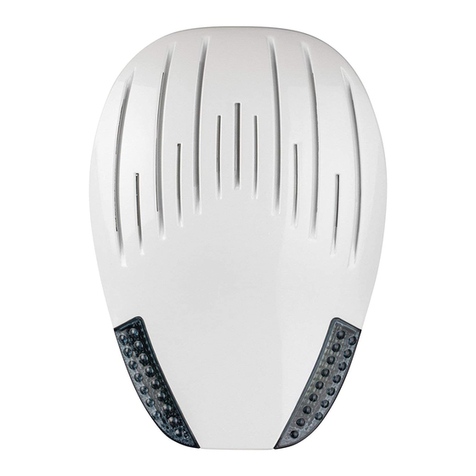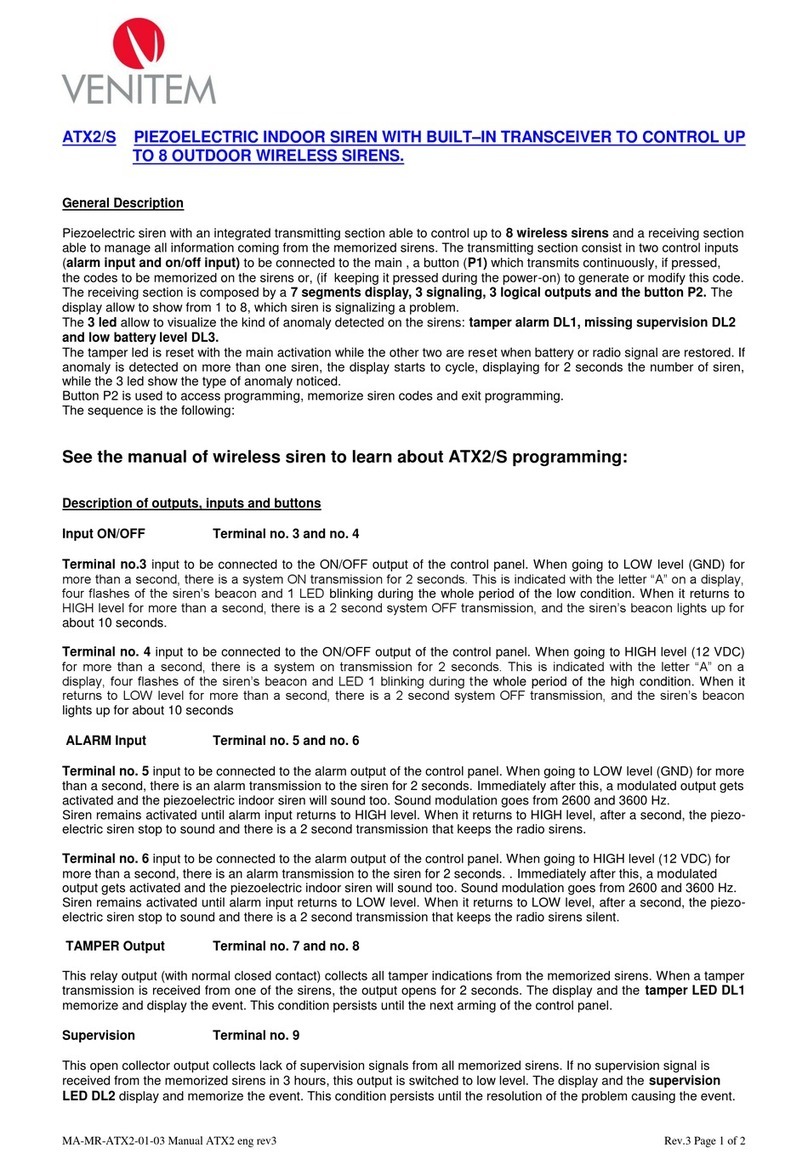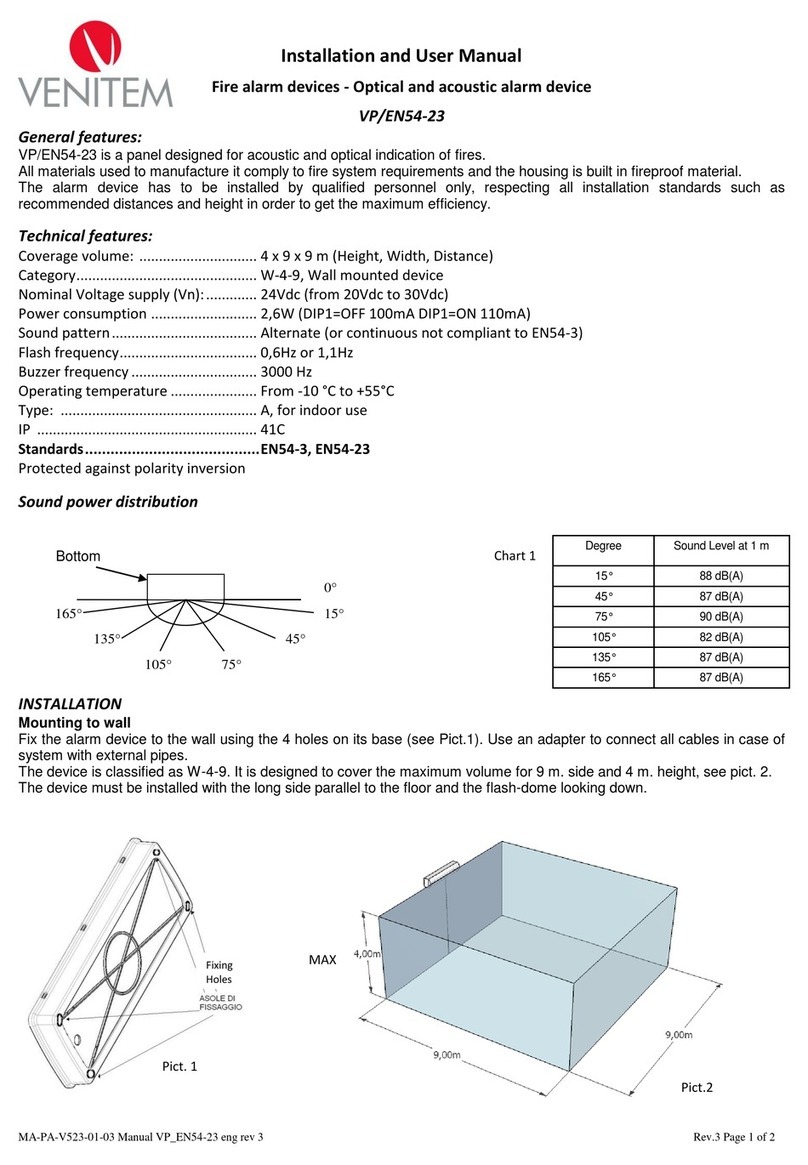
MA-SE-DCT3-01-02 Manual Doge CT3 eng rev2 Rev.4 Pagina 8 di 17
HOW TO PROCEED TO REPLACE BATTERY:
Arming of the system, disarming of the system, within 60 seconds since the cover opening.
Make the necessary steps: battery replacement etc.., 24 hours zone and anti-tamper not active, infinitive time available.
Close the cover, arm and disarm the system. 24 hours zone and anti-tamper are re-activated.
HOW TO PROCEED for complete WALK TEST:
Arm the system, disarm the system, open the cover within 60 seconds.
Make the necessary steps: replace battery, check cabling etc.
The 24 hours zone and the anti-tamper are not active, infinitive time available.
The sound of the horn is attenuated for about 1 hour.
Arm the system. Check if all detectors trigger off an alarm, check if the telephone dialer sends out the call, check that the indoor
siren sounds.
Close the cover
Arm and disarm the system.
The 24 hours zone and the anti-tamper are re-activated. High intensity sound.
HOW TO PROCEED TO CHECK the 24 hours lines and the lines balancing:
The LED LD1 visualizes the tamper open according to the priority shown in the chart “LED Tamper” so, if the LED flashes 5 times, it
means that the only opened tamper is the one on the bottom of the sounder or the cover so the zones are correctly balanced and
the 24 hours line is closed.
USE
The following behaviours have to be taken into consideration:
If a line goes in alarm, in order for it to be able to trigger off a new one at the end of the alarm cycle, it must re-balance
(condition of non-alarm) and unbalance again.
This behaviour is valid for normal alarms, for the 24 hours line and for the Reed tamper.
A delayed line still unbalanced at the end of the output time causes an alarm without waiting for the input time.
ARMING
Putting the key in position ON or pressing the pushbutton A (total) or B (partial) of the remote control, the anti-intrusion zones
activate, the zone 1 will become operative after the output time. At the same time, the indication of armed system (three flashes) or
of output time (flashes during the whole output time) switches on.
The output STI (system status) activates fix at 0V in case of total arming or intermitting in case of partial arming.
INPUT/OUTPUT TIME
After arming the control panel, the output time starts, at the same time the indication of armed system switches on and the zones 2
and 3 are operative.
Once this time is finished, the zone 1 becomes operative. At armed system, the opening of an immediate zone causes the general
alarm whilst the opening of a delayed zone activates the general alarm after the input time if the system is not disarmed meanwhile.
The duration of the input and output time is set by DIP3.
DISARMING
Putting the mechanical key in OFF position or pressing the pushbutton A or B of the remote control, the anti-intrusion lines de-
activate and the indication of active system switches off.
PARTIAL ARMING
Further to the total arming (all lines active), the control panel can also be armed in partial mode PART, with line 3 not active. This
type of arming allows to maintain protected some zones and to move freely in the zone 3.
In order to arm the system in partial mode, press the pushbutton B of the remote control, the lamp will flash to show arming. The
Led of system status lights up flashing to show partial arming.
Behaviour:
1) System armed: active system-status output. The Led of the lamp flash three times.
a) Zones 1, 2, 3 or tamper in alarm: active alarm output. Sound of the sounder for the time-lapse of DIP 1. Flashing of the Led
for infinitive time showing the first zone in alarm. The number of flashes shows the zone in alarm. If all Led flash
progressively it’s a 24 hours alarm.
b) System disarming by key or remote control, LED switching off
2) Arming with zone 1 open: if the zone is set as delayed, the lamp will flash quickly during the output time
3) Anomalies such as: Zone 1 open, low battery, mains absence, problems on battery or horn make the lamp flash quickly in any
status of the system.
4) Max number of alarms per zone: when the DIP is set on OFF, any zone causes max 4 alarms in 24 hours. Once expired the 24
hours from first alarm, zones are re-enabled to trigger off alarme. Even in case of disarming and the arming, the lines are re-
enables and the alarm counting starts again. The 24 hours has no limit in alarms number.

































